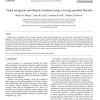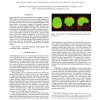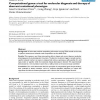237 search results - page 19 / 48 » Computational Modeling of Human Head Conductivity |
RAS
2006
13 years 8 months ago
2006
Humans have a remarkable ability to navigate using only vision, but mobile robots have not been nearly as successful. We propose a new approach to vision-guided local navigation, ...
ISBI
2011
IEEE
13 years 4 days ago
2011
IEEE
Segmenting brain from non-brain tissue within magnetic resonance (MR) images of the human head, also known as skull-stripping, is a critical processing step in the analysis of neu...
BMCBI
2007
13 years 8 months ago
2007
Background: A finite state machine manipulating information-carrying DNA strands can be used to perform autonomous molecular-scale computations at the cellular level. Results: We ...
ECBS
2005
IEEE
14 years 2 months ago
2005
IEEE
Large and complex computer based systems are the result of an evolution process which may take many years. Heterogeneity is an important characteristic of such systems: During the...
AI
2004
Springer
14 years 1 months ago
2004
Springer
If we are to understand human-level intelligence, we need to understand how meanings can be learned without explicit instruction. I take a step toward that understanding by showing...



